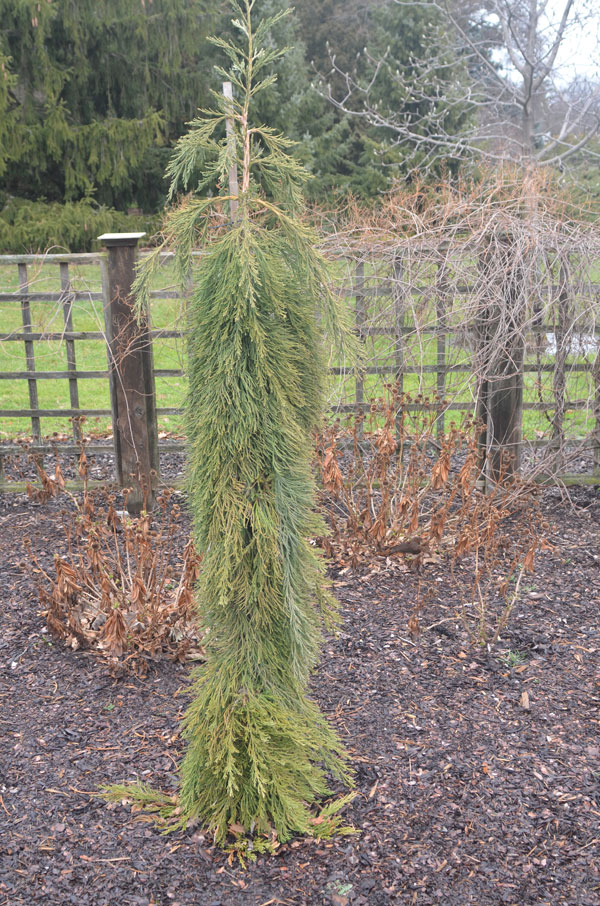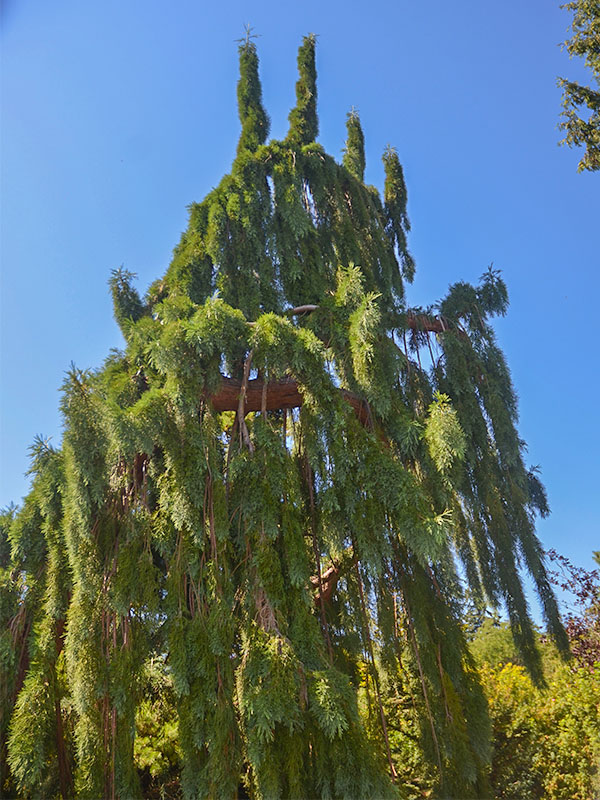
Woody > Sequoiadendron > Sequoiadendron giganteum > Sequoiadendron giganteum 'Pendulum'
Sequoiadendron giganteum
'Pendulum'
Weeping Sequoia
Origin: The species is native to slopes of the southwest United States; specifically, California's Sierra Nevada Mountains at high elevations with moist acidic soils, warm summers and cool winters. 'Pendulum' is of horticultural origin.
Mike's
Opinion


"
A very interesting and unique evergreen that is easily identifiable by its irregular, narrow and weeping, growth pattern. Adds an interesting dimension to a landscape, making it a perfect fit for a large garden or park. Tolerant of most soil types, but prefers a moist acidic soil with full sun.
Michael Pascoe, NDP., ODH., CLT., MSc. (Plant Conservation)
"
| Family |
| Taxodiaceae |
| Genus |
| Sequoiadendron |
| Species |
| giganteum |
| Cultivar |
| 'Pendulum' |
| Category |
| Woody |
| Type |
| Tree (evergreen) |
| Pronunciation |
| USDA Hardiness Zone |
| 6a - 8b |
| Canadian Hardiness Zone |
| 7a - 9b |
| RHS Hardiness Zone |
| H6 |
| Temperature (°C) |
| -23-(-18) |
| Temperature (°F) |
| 0-(-9) |
| Height |
| 8 - 14 m |
| Spread |
| 1 - 1.5 m |
Photographs
Description and Growing Information
Flowering Period
| General Description |
| A large weeping evergreen with bluish- green foliage, and a dramatic weeping form. Relatively low maintenance tree that does best in full sun and moist acidic soils. It produces brownish red cones and has a unique narrow dense shape. |
| Landscape |
| An interesting, and unique accent tree perfect for a large garden or park. It compliments a garden nicely and fits into a landscape as a finishing touch type of tree. Commonly used in parks and gardens for its unique growth pattern and dense weeping shape. |
| Cultivation |
| Does best in full sun, preferably more acidic, sandy, loamy soils, but tolerant of most soil types including mildly alkaline soils. In order to maintain it aesthetically pleasing value, mild pruning may be required of side drooping branches, especially if located in a park or garden and to a building structure. |
| Shape |
| Displays an irregular, broadly weeping, and narrow form. |
| Growth |
| Fast |
| ID Characteristic |
| Very identifiable by its upright, narrow, and weeping shape. The irregular, narrow form sometimes resembles that of a dinosaur or man, making it easy to recognize. |
| Pests |
| No known pests. |
| Habitat |
| Horticultural origin. |
| Bark/Stem Description |
| A thick but soft reddish-brown, deeply grooved trunk. |
| Leaf Description |
| The needles are sharp and scaly and approximately 1-12 cm in length. |
| Flower Description |
| Monoecious; male and female flowers are egg shaped and yellow in colour. |
| Fruit Description |
| 5- 8 cm upright ripe cones hang from the weeping side branches. With maturity the cones are a reddish-brown colour. |
| Colour Description |
| Bluish- green foliage with no particular autumn colour. The bark and branches are a reddish-brown colour which is also the colour of matured cones. |
| Texture Description |
| Medium. |
| Notable Specimens |
| The VanDusen Botanical Garden, Vancouver, British Columbia, Canada. Niagara Parks Botanical Gardens, Niagara Falls, Ontario, Canada. Pinetum Park and Pine Lodge Gardens, Cornwall, England. |
| Propagation |
| Softwood cuttings. |
References
"Tree Info." Van Den Berk Nurseries. N.p., n.d. Web. 22 Mar. 2012. .

